With over 450 different varieties of seafood and imports from 60 countries on six continents, if you don't like seafood, you shouldn't be here! Tsukiji is a commercial market. The customers here bulk buy for restaurants, supermarkets and fishmongers.
We arrived at Tsukiji at about 5.30am, sleepily shuffling along the 10-minute walk from Tsukiji station as dawn broke through with milky light. Men stomped past us wearing gumboots. Fishmongers slurped noodles noisily at the noodle bars lining the streets.
Inside, there was, well... fish. And plenty of it. Stalls and stalls of styrofoam box towers brimmed with fresh seafood. The floor was wet, the aisles were narrow, and every now and then you had to fling yourself out of the way of a roaring motorised tricycle cart--these hurtling blue carts stopped for noone. Bare light globes swung overhead, casting harsh circles of light on the various seafood. The lack of fishy smell is something that everyone comments on, and it's true--the stuff is so fresh, you can't smell anything.
~~~~~~~~~~~~~~~~~~~~~~~
GrabYourFork needs your help!
I've decided to try and identify the contents of each picture. Show off your foodie expertise, and if you can help with any unknown item or provide extra detail, eg.
- specific variety name
- its name in Japanese
- how it is traditionally cooked
- or perhaps even a correction
fill out the comments section at the end of this entry and include the corresponding picture reference letter. I'll edit the picture captions with your info and give credit where credit's due. Thanks!
PS. Click on individual images to open up a larger version.
~~~~~~~~~~~~~~~~~~~~~~~
A. fish fish thinks this might be hamaguri, a type of clam which Japanese love. However this looks a bit bigger than the type normally seen in the market, she says.
[Thanks fish fish]
B Surumeika, a very common and famous type of squid
[Thanks fish fish]
C Shinika squid, a new variety of squid of Awaji, an area in Hyogo prefecture. This area is famous for its sea products
[Thanks fish fish]
D fish fish thinks this might be kegani, a hairy crab. Kegani is actually a specialty from Hokkaido.
[Thanks fish fish]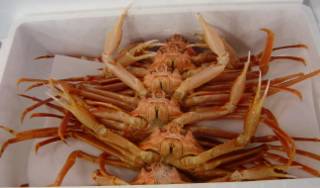
E fish fish thinks this is zuwaijani, the most common kani (crab) species in Japan. "A good time to eat crab is during winter", she says.
[Thanks fish fish]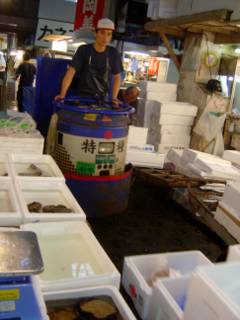
The funny looking tricycle carts are so designed as the special wheel and motor at the front can be turned in all directions, allowing them to turn in very tight spaces.
F Hotate, or Japanese scallops. They are huge!
G Kurumaebi, a common prawn species in Japan
[Thanks fish fish]
H Botanebi, a higher grade variety of prawn in Japan. "This is usually served as raw sushi in restaurants", says fish fish. A example of this sushi-style is available here.
[Thanks fish fish]
TUNA AUCTION
The point where my foodie heart leapt into my throat was catching sight of the tuna auction room. Hundreds of neat rows of frozen tuna lay on the concrete floor as serious-looking men in gumboots examined them all thoroughly--poking them with a hook on a pole, examining the incisioned flesh intently with torches, and constantly muttering to themselves whilst they jotted notes.
Every day hundreds of tuna arrive in Japan by cargo jet, with individual tuna weighing from 91 to 454kg (200 to 1,000 pounds). With the ring of a bell, an auction begins and the cacophony of yells and frantic calling from the bidders is encouraged by the auctioneer who booms heart-thumping encouragement. With each tuna auction lasting about 9 seconds, the clamour is deafening yet adrenalin-inducing.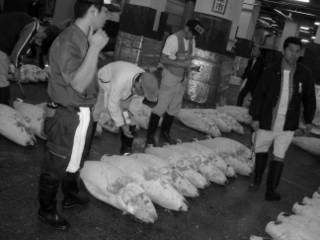
Tuna inspection is a very serious business
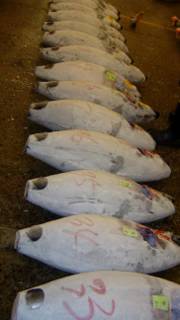

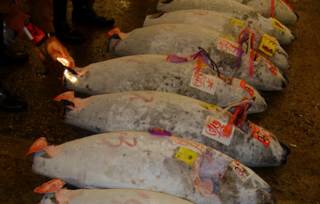
Back out in the retail area...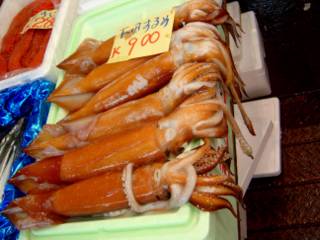
I A bigger version of surumeika squid, says fish fish. She also points out that surumeika is often used for processing into dry squid.
[Thanks fish fish]
J Tako or octopus, says fish fish. Boiled octopus is called yudako (wow, you're a wealth of knowledge fish fish!
[Thanks fish fish]
K fish fish says this is anago, a type of eel, smaller than unagi.
[Thanks fish fish]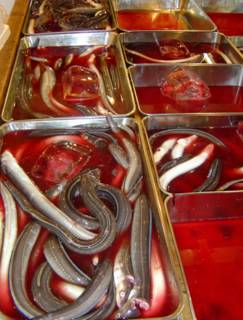
L This is unagi, says fish fish. "This big variety of eel is particularly famed in Hamatsu. When this eel is cooked, the Japanese call it kabayaki, or broiled eel", she explains.
[Thanks fish fish]
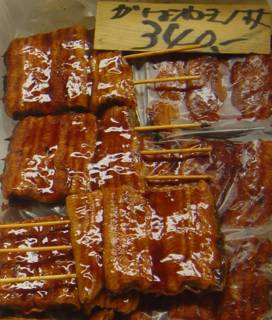
Unagi or cooked eel. I've always loved eel Japanese-style. It's so sweet, rich and tasty--and the sauce is so moreish on a bowl of fluffy white rice.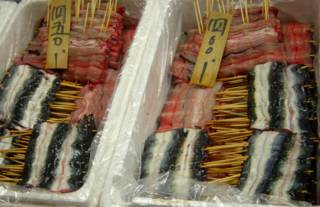
Raw eel skewers. We saw the eel skewerer machine which was quite a nifty contraption. The eel fillet is placed onto a metal plate, the hinged contraption overhead is pulled down, then *hiss* as four skewers pierce the fillet, lift the lid and voila, instant skewer! We were impressed anyway.
The tuna purchased from auction are either loaded into trucks for transport, or moved on motorised carts to individual stalls. There the shop owners cut and prepare the products for retail.



If my research is correct, this is an oroshi hocho, or wholesale knife. "The oroshi hocho has a blade length of 150 cm in addition to a 30 cm handle. Usually two or three people are needed to handle the knife and the tuna."

Filleting tuna (maguro) with a hancho hocho, or half tool knife. "The hancho hocho is the shorter blade with a length of around 100 cm in addition to the handle. The hancho hocho is also sometimes called a maguro kiri."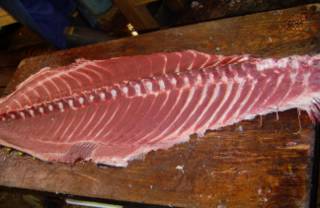

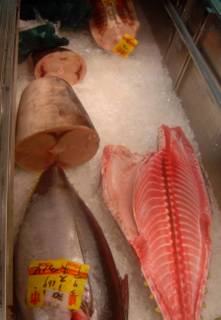
An interpreter uncovered that this was A Grade tuna.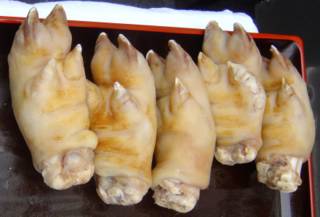
M Pigs trotters
N Mink whale [thanks MCAT]

More of the same (we presume).
O Sazae--a turban shell, says fish fish. "This is usually cooked in its own shell and eaten by adding some lime and soy sauce", says fish fish.
[Thanks fish fish]
P Flathead, specifically stargazers?
These were alive and swimming about in an aerated styrofoam box
[Thanks R and SL]
Q Flathead
[Thanks SL]
R Maboya or sea squirt (Halocynthia roretzi) similar to Australian cunjevoi Click here for eating instructions
[Thanks SL - I was hoping someone would know what this one was!]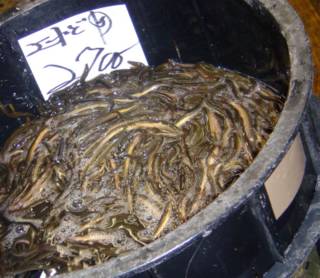
S Dojo [thanks Anon]
These were alive and slithering frantically in the aerated water, almost threatening to jump out at you if you weren't careful!
The styrofoam cemetery.
The streets surrounding Tsukiji are lined with local markets selling everything from mushrooms to crockery.
T Matsutake mushrooms. "These are one type of high class mushroom in Japan", fish fish explains. "They are expensive because they still cannot be cultivated. Japanese pride it for its typical brittle texture and aroma, which other mushrooms don't enjoy. Japanese matsutake are different from Korean and Canadian varieties--the Japanese tops resemble a round button, whereas the Korean and Canadian varieties look more like an umbrella. Prices differ greatly too and so does the taste."
[Thanks fish fish--a veritable font of gastronomic knowledge!]
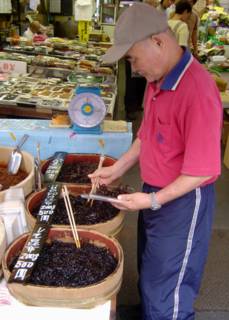
Seaweed
U

V Natural maitake--another variety of normal mushroom in Japan, says fish fish. These are now commonly cultivated which is reflected in lower prices. Wild maitake would still be expensive though. Fish fish likes to use maitake for tempura.
[Thanks fish fish]
W Geta, or Japanese slippers.
[Thanks fish fish]
X Touki or chinaware. We were to see the importance of small crockery bowls in Japanese meal presentation repeatedly. These bowls were number half-a-dozen on your tray, each containing a different pickled taste sensation.
[Thanks for the Japanese name for this fish fish]
Y Calligrapher at work. I'm not sure what the tablets say. The Japanese word for calligraphy is shodo, says fish fish.
[Thanks fish fish]
Z I have no idea what this poster is about (I presume it is encouraging healthy eating), but it just looks so Japanese!
Fish fish to the rescue again. The poster reads: "Yoroshikune! Kochi no Genki na Yasaitachi. Terebi CM housouchu! Heisei 16 nen 1 gatsu sue kara 2 gatsu sue made. Means Please remember us! The healthy vegetables in Kochi area. The commercial in TV is broadcasting. From end of Jan till end of Feb of 2004. (The heisei 16 year is equivalent to 2004).
[Thanks fish fish]
BREAKFAST
By now it was 7.30am, we'd been up for 3.5 hours, we'd been staring at seafood all morning--it was time for a sushi breakfast! We headed to Sushizanmai, a sushi chain probably aimed at the tourist market, but we were tired, we were hungry and we wanted sushi!
As we entered an almight cry of Irrashaimase or "welcome", greeted us. As is Japanese custom, every waiter, shop assistant, shelf-stacker--basically any employee--must greet every customer they see or encounter. As other customers entered the sushi bar, an aural Mexican wave of staggered Irrashaimase's would cut through the general breakfast chatter.
Twelve sushi chefs manned the counter, taking orders from customers and deftly preparing sushi and sashimi (in between yelling Irrashaimase). The touch was light, the fingers were quick, as rice and fish were transformed into gastronomic works of art.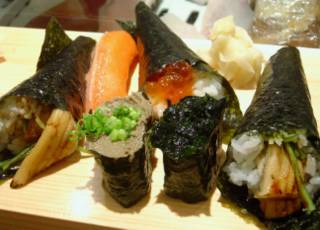
After much deliberation over the picture menu, my final breakfast was:
(Clockwise from left) Sea eel and cucumber hand roll, 200yen
Salmon nigiri, 98yen
Salmon roe hand roll, 250yen
Sea eel and cucumber hand roll, 200yen (this duplicate actually belonged to my friend next to me)
Spontaneous purple laver, 128yen
Crab guts, 128yen
Yes, how could GYF resist the allure of crab guts and spontaneous purple laver? The crab guts were minced into a delicate puree and reminded me of those final pickings of the mud crab at seafood dinners. However the taste was probably more refined. The spontaneous purple laver didn't strike me as being particularly "impulsive" nor was there much taste to it. A bit of a anticipatory letdown, it pretty much tasted like cooked seaweed.
The sea eel was delicate and subtly tasty; the salmon roe was joy with every bursting salty mouthful.
As much as this piece of salmon nigiri resembles a slug, the salmon itself was unbelievably fresh and tasty. On the tongue, the salmon felt velvety soft in texture and almost dissolved in the mouth without the need to chew. Plump and smooth, I can almost taste it now...
Sushizanmai
10-8, Tsujuki4-Chome, Chuo-ku, Tokyo
Tel: 03 5148 3737
Open 24 hours, 7 days a week
Tsukiji Fish Market
Nearest subways:


What a mammoth effort darls. This must have taken you all evening to put this together, but it is fantastic.
ReplyDeleteThe only picture I feel confident trying to name is the fish in P. I think they are similar to flathead, and are called stargazers (because both eyes are on top of their head).
Keep up the good work.
I am looking forward to the next installment.
Ok, I have my info below helpful for you. Not everything I know, just tell you the things that I know. :)
ReplyDeleteA. This looks like Hamaguri (蛤) to me. Not really sure, it's a bit too big for hamaguri that I usually see in the market. A kind of clam. Japanese love it.
B. Surumeika (スルメ烏賊). One type of squid species, very common and famous one.
C. Shinika (新烏賊). New squid from Awaji, an area in Hyogo prefecture. Famous with sea product.
D. Looks like a Kegani (毛蟹) to me. Hairy crab. Not so sure. Cause Kegani is actually a famous product in Hokkaido.
E. I believe this is the Zuwaijani (ズワイガニ). The most common kani (crab) species in Japan. Good time to eat crab is during winter.
G. Kurumaebi (車海老). A type of common prawn species in Japan.
H. Botanebi (ボタン海老). A type of more high class prawn in Japan. Usually they serve as raw sushi in restaurant.
http://kuishinbomeow.blogspot.com/2004/08/7-august-2004-1.html#comments
U can refer this site for how they look in sushi style. :)
I. Another Surumeika pic. This one bigger. :) Surumeika oso common to be processed into dry squid.
J. Tako (蛸). Octopus. But boiled octopus is call Yudako.
K. Anago (穴子). A type of eel. Smaller than unagi. I'm a vegetarian, dun really know how the taste.
L. Unagi (鰻). Another type of eel. Big eel. Famous product in Hamamatsu. The cooked eel usually Japanese called Kabayaki (蒲焼き), meaning broiled eel.
O. Sazae (サザエ). A turban shell. Usually Japanese eat this sell in 'a turbo cooked in its own shell' style. Adding some lime and soysauce.
T. Matsutake (松茸). One type of high class mushroom in Japan. It is expensive because it still can't be cultivated yet. Japanese like it for its typical brittle texture and nice smelling where other type of mushroom don't have. Japanese Matsutake very different from Korean or Canadian matsutake. See the top of the Japanese one? Look like a round button, whereas the normal Korean or Canadian one looks like an umbrella. Price are greatly differed too. So do the taste.
V. Natural maitake (舞茸). Another type of normal mushroom in Japan. Has been commonly cultivated, so very cheap price to for the cultivated one. But for the wild type one, I think, the price will be much more expensive, and the taste will be different too. I like maitake, great mushroom to make into tempura.
W. Geta (下駄). Japanese wooden slipper.
X. Touki (陶器). Chinaware.
Y. Shodo (書道). Calligraphy.
Z. It is read as "Yoroshikune! Kochi no Genki na Yasaitachi. Terebi CM housouchu! Heisei 16 nen 1 gatsu sue kara 2 gatsu sue made. Means Please remember us! The healthy vegetables in Kochi area. The commercial in TV is broadcasting. From end of Jan till end of Feb of 2004. (The heisei 16 year is equivalent to 2004).
:P Sorry for busybody so much. Just want to help to solve some of the doubts. ;)
wow! the posting is very educational and helpful especially to all those who love to eat fish. not to mention the nutritional part of the fish to our health. but i'm really a sushi-lover. i have also been to this place just to eat sushi at sushizanmai early in the morning.i've tried eating in different branches of sushizanmai in tokyo. and it's a funny experience for me, after so many years, i had acquainted with the owner of this sushi chain which i never expected to.
ReplyDeletei would like to contribute one name of the fish (i'm not sure if this is correct, hope it is)
S "dojo"?
Hi I enjoy your blog a lot. As a fellow food lover and Japanese national, I particularly read your entries of Ramen with interest. I recently travelled to Sydney and referred to your blogs and went to Gumshara and Menya. N is yes, mink whale, which is a politically sensitive food subject.
ReplyDeleteWhoops, how did I missed responding to all these comments?
ReplyDeleteHi R - Thanks for the info on stargazers.
Hi SL - Thanks for your identification help.
Hi fishfish - Thank you for such a comprehensive listing! I amended the post but never officially responded to your comment so thank you again! :)
Hi Anon - You could be right! Thanks so much!
Hi MCAT - Thank you for all your comments and glad you found Grab Your Fork useful on your trip to Sydney. Would love to hear what you thought of Gumshara and Menya (perhaps if you comment on those individual posts, rather than here?). Thanks for confirming mink whale too - I agree, there's a lot of sensitivities involved!